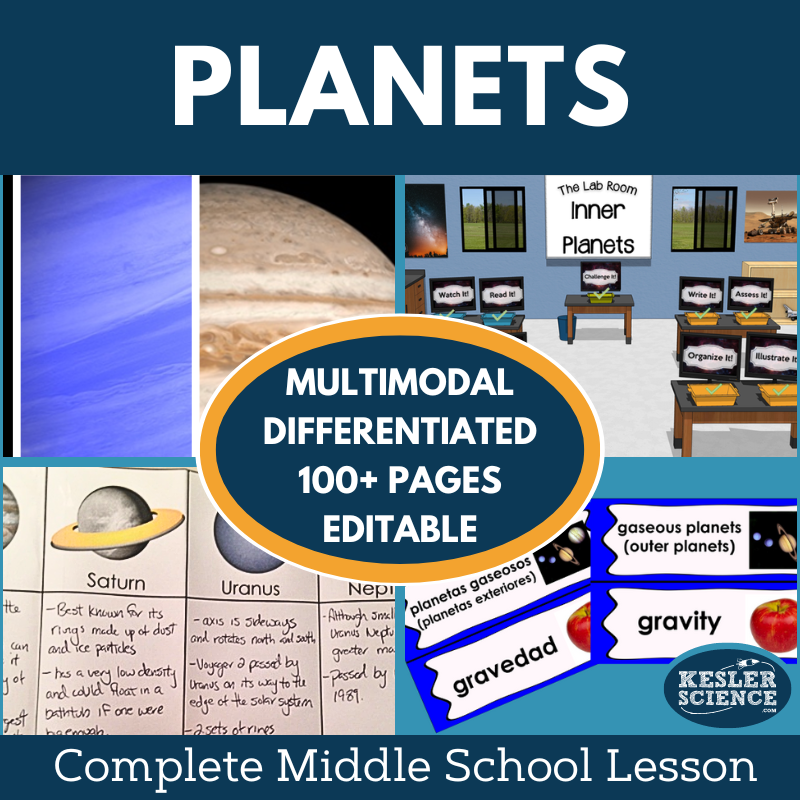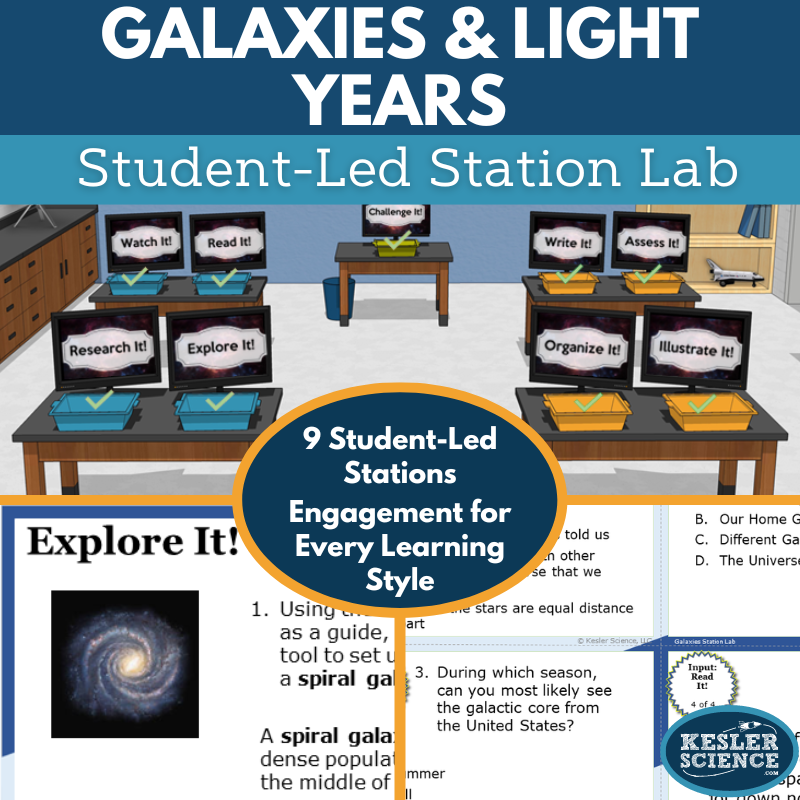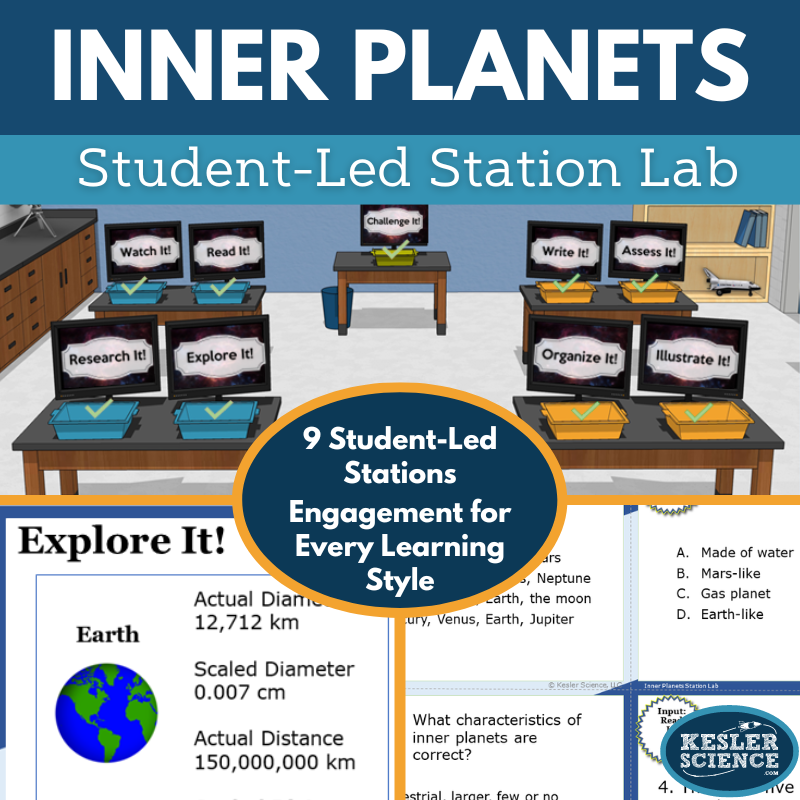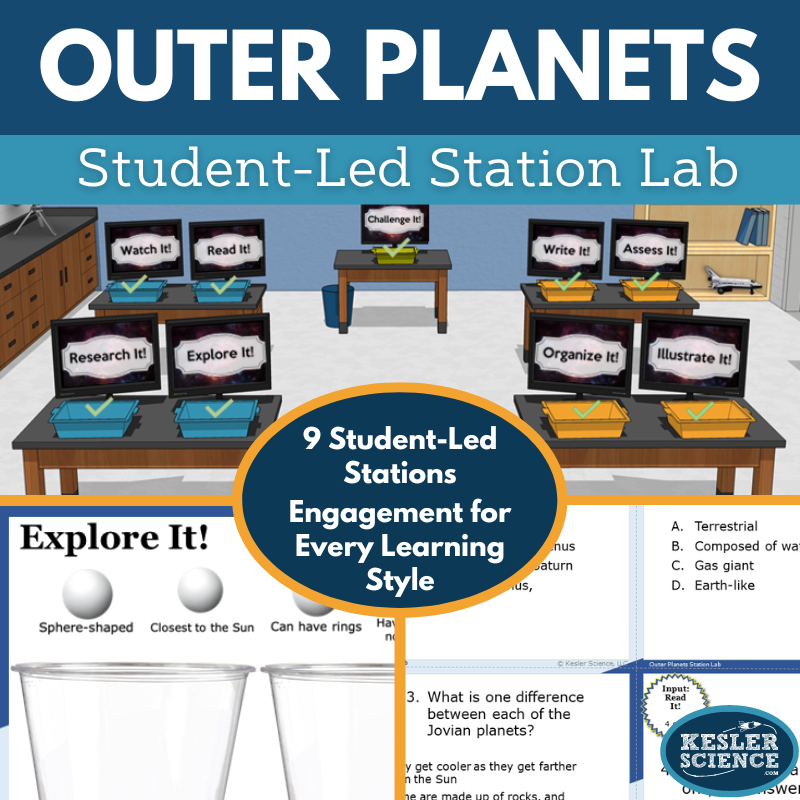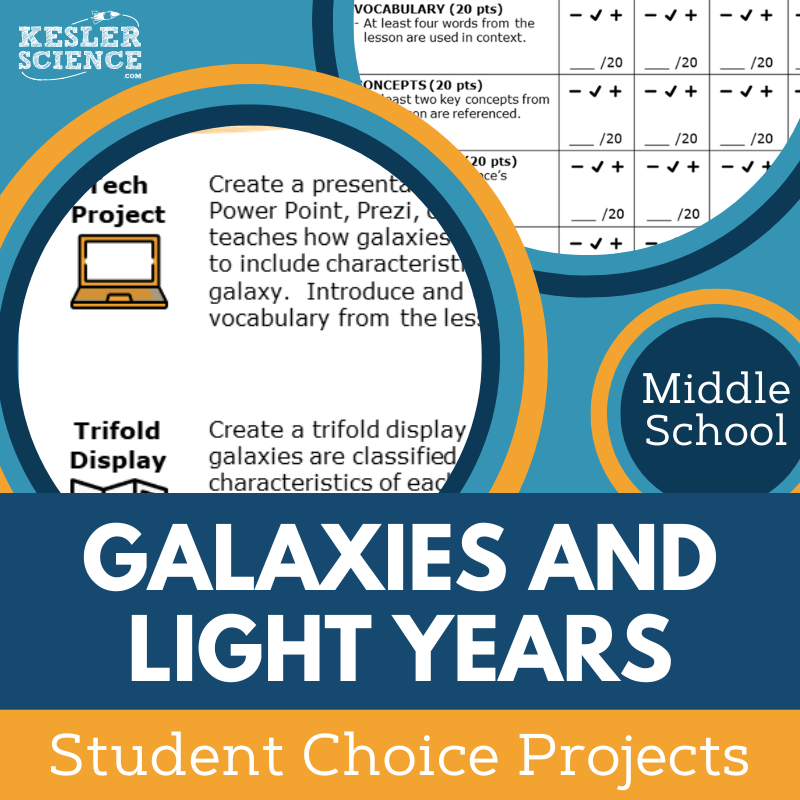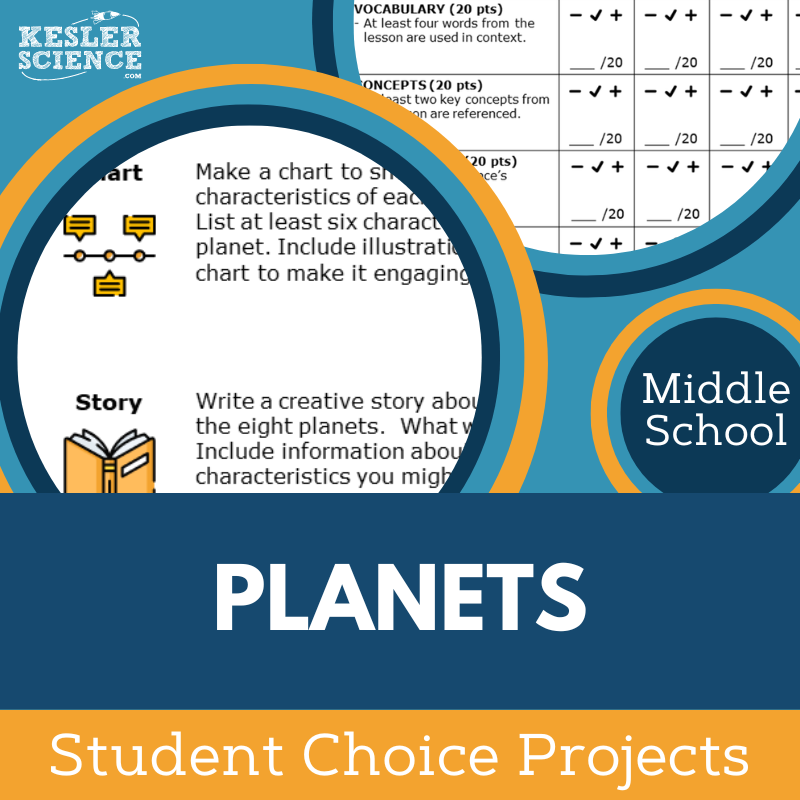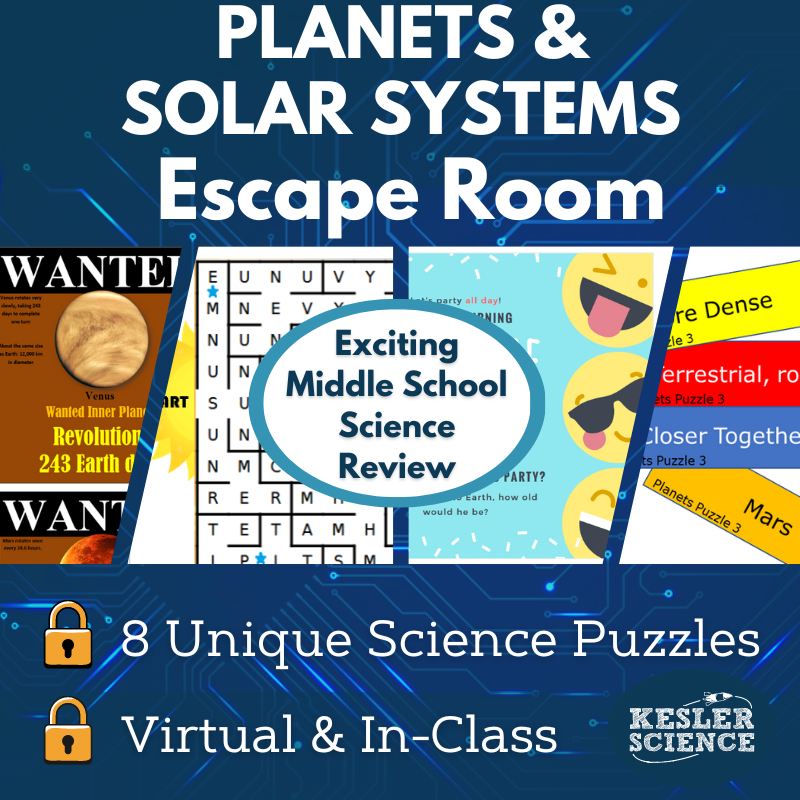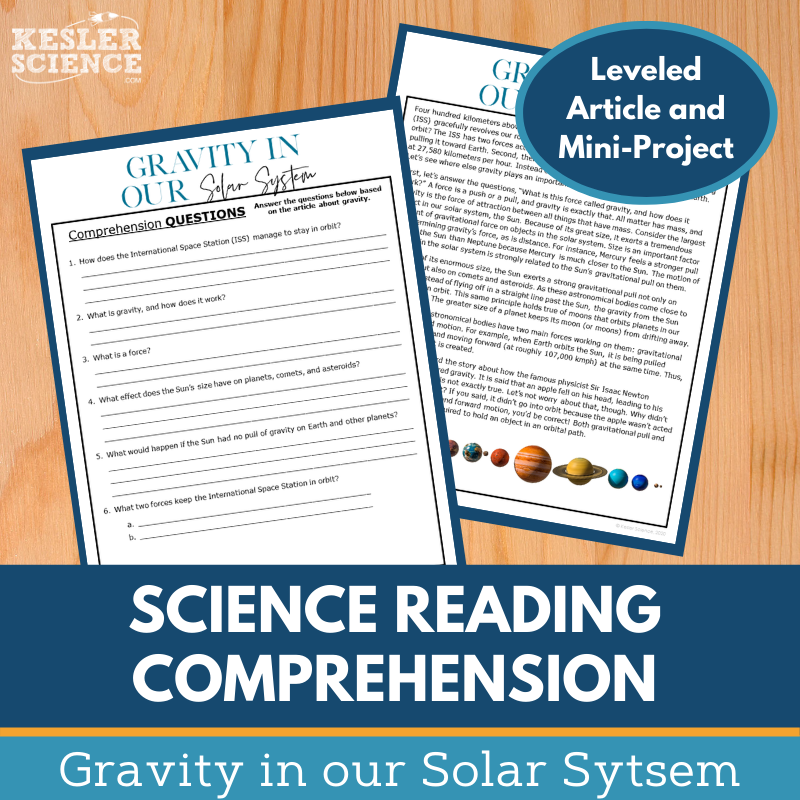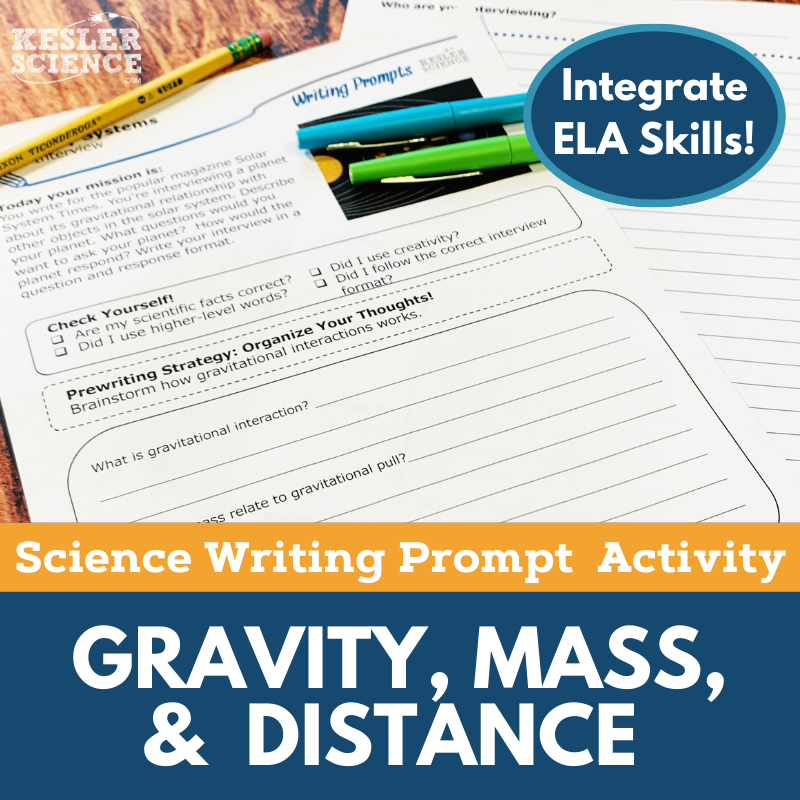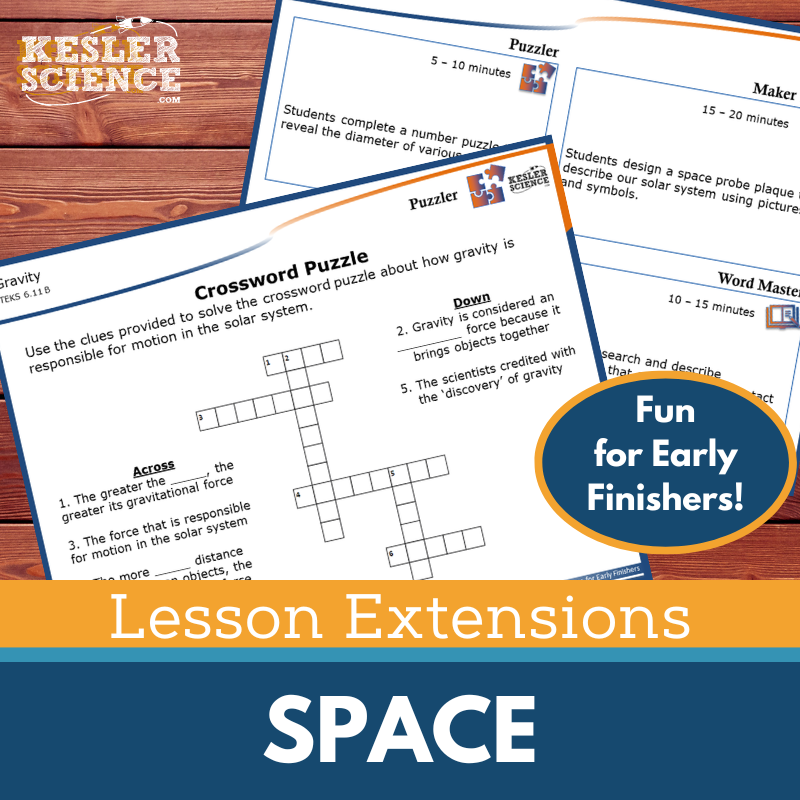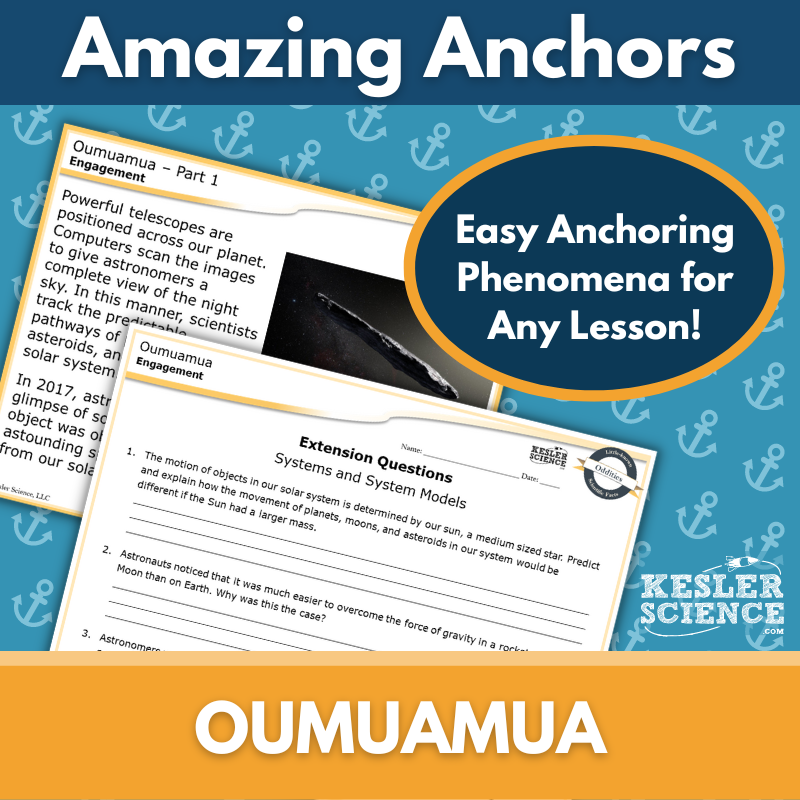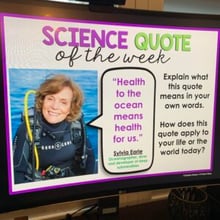Gravity & Our Solar System Activities for Middle School Science
The Galaxies and Light Years and Planets (Inner & Outer) 5E Lessons engage middle school students in student-led explorations of space science using the 5E Model. The resources below will give students a comprehensive understanding of gravity and our solar system. All of the following materials are also included in the Kesler Science Membership.
The Kesler Science Galaxies and Light Years 5E Lesson is a comprehensive unit designed for middle school students, incorporating engaging, differentiated, and student-led learning. It includes editable presentations, worksheets, assessments, and student-choice projects, with minimal prep required. The lesson aligns with NGSS and integrates multimodal learning to accommodate diverse learners.
Following the 5E Model, the lesson begins with engagement activities, including word wall cards and class discussions. Exploration involves a student-led station lab with nine stations, offering hands-on activities, reading comprehension in English and Spanish, research tasks, video discussions, categorization exercises, writing prompts, illustrations, assessments, and a challenge station for extension. Explanation features editable PowerPoints, interactive notebooks, and note-taking templates. Elaboration allows students to extend their learning through choice projects, while evaluation includes STAAR 2.0-aligned assessments, review questions, and worksheets.
The lesson is available in printable and digital formats, with Spanish translations for key materials. It is flexible for in-person and virtual learning, ensuring accessibility for all students.
The Kesler Science Galaxies and Light Years 5E Lesson is a comprehensive unit designed for middle school students, incorporating engaging, differentiated, and student-led learning. It includes editable presentations, worksheets, assessments, and student-choice projects, with minimal prep required. The lesson aligns with NGSS and integrates multimodal learning to accommodate diverse learners.
Following the 5E Model, the lesson begins with engagement activities, including word wall cards and class discussions. Exploration involves a student-led station lab with nine stations, offering hands-on activities, reading comprehension in English and Spanish, research tasks, video discussions, categorization exercises, writing prompts, illustrations, assessments, and a challenge station for extension. Explanation features editable PowerPoints, interactive notebooks, and note-taking templates. Elaboration allows students to extend their learning through choice projects, while evaluation includes STAAR 2.0-aligned assessments, review questions, and worksheets.
The lesson is available in printable and digital formats, with Spanish translations for key materials. It is flexible for in-person and virtual learning, ensuring accessibility for all students.
The Kesler Science Planets (Inner & Outer) Complete Lesson on the characteristics and movements of inner and outer planets is a fully editable, engaging middle school unit designed for differentiated, student-led learning. It includes presentations, worksheets, choice projects, and assessments, all requiring minimal prep.
Students will explore key questions about planetary properties and movements through a 5E Model framework: engagement activities, a hands-on, multimodal exploration station lab, and explanation materials such as interactive PowerPoints and digital or print interactive notebook templates. The elaboration phase includes student-choice projects, while evaluation features STAAR 2.0-aligned assessments and review worksheets.
This lesson offers flexible formats, including printable and digital options, along with Spanish translations for vocabulary, reading passages, and notebook pages. It supports virtual learning, ensuring accessibility both in-class and online.
The Kesler Science Planets (Inner & Outer) Complete Lesson on the characteristics and movements of inner and outer planets is a fully editable, engaging middle school unit designed for differentiated, student-led learning. It includes presentations, worksheets, choice projects, and assessments, all requiring minimal prep.
Students will explore key questions about planetary properties and movements through a 5E Model framework: engagement activities, a hands-on, multimodal exploration station lab, and explanation materials such as interactive PowerPoints and digital or print interactive notebook templates. The elaboration phase includes student-choice projects, while evaluation features STAAR 2.0-aligned assessments and review worksheets.
This lesson offers flexible formats, including printable and digital options, along with Spanish translations for vocabulary, reading passages, and notebook pages. It supports virtual learning, ensuring accessibility both in-class and online.
Engage your middle school students with this student-led station lab on galaxies and light years. Designed for in-class or virtual learning, this lesson guides students as they develop and use models to describe gravity’s role in the motions of galaxies and the solar system through nine interactive stations.
Students explore concepts through hands-on demonstrations, research activities, readings, and videos. They demonstrate understanding by organizing information, illustrating models, writing responses, and completing assessments. A challenge station provides extension activities for early finishers. Differentiated reading passages in English and Spanish support diverse learners.
This low-prep, high-engagement resource fosters independent learning and critical thinking.
Engage your middle school students with this student-led station lab on galaxies and light years. Designed for in-class or virtual learning, this lesson guides students as they develop and use models to describe gravity’s role in the motions of galaxies and the solar system through nine interactive stations.
Students explore concepts through hands-on demonstrations, research activities, readings, and videos. They demonstrate understanding by organizing information, illustrating models, writing responses, and completing assessments. A challenge station provides extension activities for early finishers. Differentiated reading passages in English and Spanish support diverse learners.
This low-prep, high-engagement resource fosters independent learning and critical thinking.
Engage your middle school students with this student-led station lab on the inner planets. Designed for in-class or virtual learning, this interactive lesson helps students understand that gravity governs the motion of our solar system through nine differentiated stations featuring videos, readings, research, and hands-on activities.
Students demonstrate their learning by organizing information, illustrating models, writing responses, and completing assessments. A challenge station provides extension activities for early finishers. All stations include necessary signage, literature, and resources, with minimal additional materials needed.
This low-prep, high-engagement resource fosters independent learning and critical thinking, making it a valuable addition to your space science curriculum.
Engage your middle school students with this student-led station lab on the inner planets. Designed for in-class or virtual learning, this interactive lesson helps students understand that gravity governs the motion of our solar system through nine differentiated stations featuring videos, readings, research, and hands-on activities.
Students demonstrate their learning by organizing information, illustrating models, writing responses, and completing assessments. A challenge station provides extension activities for early finishers. All stations include necessary signage, literature, and resources, with minimal additional materials needed.
This low-prep, high-engagement resource fosters independent learning and critical thinking, making it a valuable addition to your space science curriculum.
Engage your middle school students with this student-led station lab on the outer planets, designed to explore how gravity governs the motion of our solar system. This modular, differentiated activity allows students to direct their own learning while teachers facilitate rather than instruct.
The lab includes nine interactive stations that encourage exploration through videos, readings, research, and hands-on activities. Input stations introduce new concepts through demonstrations, research tasks, reading passages in English and Spanish, and video analysis. Output stations allow students to demonstrate understanding by organizing information, illustrating models, writing responses, and completing assessments. A challenge station offers extension activities for early finishers.
This resource is designed for both in-class and virtual learning, providing a flexible and engaging way for students to deepen their understanding of planetary science.
Engage your middle school students with this student-led station lab on the outer planets, designed to explore how gravity governs the motion of our solar system. This modular, differentiated activity allows students to direct their own learning while teachers facilitate rather than instruct.
The lab includes nine interactive stations that encourage exploration through videos, readings, research, and hands-on activities. Input stations introduce new concepts through demonstrations, research tasks, reading passages in English and Spanish, and video analysis. Output stations allow students to demonstrate understanding by organizing information, illustrating models, writing responses, and completing assessments. A challenge station offers extension activities for early finishers.
This resource is designed for both in-class and virtual learning, providing a flexible and engaging way for students to deepen their understanding of planetary science.
The Galaxies and Light Years Student Choice Projects align with NGSS science standards, allowing middle school students to select a project that fits their preferred output style. A project page outlines six student-led options plus a “design your own” project, with an editable rubric for teacher, peer, or self-assessment.
These flexible, multimodal projects provide creative ways for students to demonstrate their understanding. Two versions of the project page support differentiation, offering modified options for students needing remediation and challenge opportunities for advanced learners. Teachers can adjust the rubric to fit grading needs.
The projects use standard classroom supplies like paper, markers, and scissors, with many options available for digital completion. Some crafting supplies may be useful for building models.
The Galaxies and Light Years Student Choice Projects align with NGSS science standards, allowing middle school students to select a project that fits their preferred output style. A project page outlines six student-led options plus a “design your own” project, with an editable rubric for teacher, peer, or self-assessment.
These flexible, multimodal projects provide creative ways for students to demonstrate their understanding. Two versions of the project page support differentiation, offering modified options for students needing remediation and challenge opportunities for advanced learners. Teachers can adjust the rubric to fit grading needs.
The projects use standard classroom supplies like paper, markers, and scissors, with many options available for digital completion. Some crafting supplies may be useful for building models.
The Planets Student Choice Projects lesson allows middle school students to select a project that matches their preferred output style. A project page outlines six student-led options plus a “design your own” project, with a grading rubric for teacher, peer, or self-assessment. These flexible, multimodal projects give students creative ways to demonstrate their understanding. Teachers can modify the rubric to fit their grading needs.
Two versions of the project page support differentiation, with a modified version offering targeted options for students needing remediation and opportunities for advanced learners to combine projects. The projects use standard classroom supplies like paper, markers, and scissors, with many options available for digital completion.
The Planets Student Choice Projects lesson allows middle school students to select a project that matches their preferred output style. A project page outlines six student-led options plus a “design your own” project, with a grading rubric for teacher, peer, or self-assessment. These flexible, multimodal projects give students creative ways to demonstrate their understanding. Teachers can modify the rubric to fit their grading needs.
Two versions of the project page support differentiation, with a modified version offering targeted options for students needing remediation and opportunities for advanced learners to combine projects. The projects use standard classroom supplies like paper, markers, and scissors, with many options available for digital completion.
The Gravity and Motion Inquiry Lab aligns with NGSS MS-ESS1-2, helping students develop a model to understand how gravity influences planetary motion. Students explore inertia and gravity’s effects on planetary orbits through either a hands-on experiment or an interactive virtual lab with a pre-recorded demonstration. Both formats include comprehension questions, C.E.R. prompts, and reflection sections.
The lab is differentiated into three levels: dependent (guided inquiry), modified (structured with additional support), and independent (student-led). The print version includes a hands-on experiment using marbles, balls, and fabric, while the digital version features an interactive PowerPoint compatible with Google Slides, requiring no materials.
Teachers can customize editable files, and included resources such as teacher guides, answer keys, and standards-aligned materials support planning and instruction.
The Gravity and Motion Inquiry Lab aligns with NGSS MS-ESS1-2, helping students develop a model to understand how gravity influences planetary motion. Students explore inertia and gravity’s effects on planetary orbits through either a hands-on experiment or an interactive virtual lab with a pre-recorded demonstration. Both formats include comprehension questions, C.E.R. prompts, and reflection sections.
The lab is differentiated into three levels: dependent (guided inquiry), modified (structured with additional support), and independent (student-led). The print version includes a hands-on experiment using marbles, balls, and fabric, while the digital version features an interactive PowerPoint compatible with Google Slides, requiring no materials.
Teachers can customize editable files, and included resources such as teacher guides, answer keys, and standards-aligned materials support planning and instruction.
The Planets Escape Room is an engaging activity that allows students to demonstrate their understanding of the characteristics of inner and outer planets in our solar system. Designed to align with NGSS standards MS-ESS1-2 and MS-ESS1-3, this escape room challenges students to develop models and analyze data related to planetary motion and scale properties.
Teachers have full control over the eight independent puzzles, choosing which to use and in what order, making it adaptable for different class lengths. The escape room can be conducted using simple materials like manila envelopes or a more immersive setup with locks and a storage box.
A digital version is available for individual students through PowerPoint or Google Slides, and a printable version can be shared as a PPT or PDF for home use. The resource includes teacher directions, detailed answer keys, an editable teacher version, a digital answer sheet for Google Classroom, a video challenge, printable props, prize ideas, reward templates, and themed signs for post-activity photos. This exciting, standards-aligned experience will keep students engaged and eager to learn.
The Planets Escape Room is an engaging activity that allows students to demonstrate their understanding of the characteristics of inner and outer planets in our solar system. Designed to align with NGSS standards MS-ESS1-2 and MS-ESS1-3, this escape room challenges students to develop models and analyze data related to planetary motion and scale properties.
Teachers have full control over the eight independent puzzles, choosing which to use and in what order, making it adaptable for different class lengths. The escape room can be conducted using simple materials like manila envelopes or a more immersive setup with locks and a storage box.
A digital version is available for individual students through PowerPoint or Google Slides, and a printable version can be shared as a PPT or PDF for home use. The resource includes teacher directions, detailed answer keys, an editable teacher version, a digital answer sheet for Google Classroom, a video challenge, printable props, prize ideas, reward templates, and themed signs for post-activity photos. This exciting, standards-aligned experience will keep students engaged and eager to learn.
This Gravity in Our Solar System Science Reading Comprehension Lesson helps students explore how gravity governs the motion of our solar system. Designed for middle school, the leveled passage supports science literacy and reading comprehension.
The resource includes two leveled nonfiction articles (Lexile 1100-1300), five to seven comprehension questions, a hands-on mini-project where students create and launch a straw rocket, and a Cornell notes template.
Perfect for sub plans, extra credit, ISS, or whole-class instruction, this resource fosters critical thinking, classroom discussions, and textual analysis. It is compatible with Google Classroom, MS Teams, Schoology, and Canvas, making it suitable for both in-person and virtual learning.
This Gravity in Our Solar System Science Reading Comprehension Lesson helps students explore how gravity governs the motion of our solar system. Designed for middle school, the leveled passage supports science literacy and reading comprehension.
The resource includes two leveled nonfiction articles (Lexile 1100-1300), five to seven comprehension questions, a hands-on mini-project where students create and launch a straw rocket, and a Cornell notes template.
Perfect for sub plans, extra credit, ISS, or whole-class instruction, this resource fosters critical thinking, classroom discussions, and textual analysis. It is compatible with Google Classroom, MS Teams, Schoology, and Canvas, making it suitable for both in-person and virtual learning.
The Gravity, Mass, and Distance Science Writing Prompt Activity engages middle school students in a creative songwriting exercise to reinforce their understanding of gravity’s role in the motions within galaxies and the solar system. Aligned with NGSS MS-ESS1-2, this low-prep, student-centered activity encourages science reasoning and exploration while supporting both in-person and virtual learning.
This resource includes teacher directions with an answer guide, project ideas, and rubrics. It offers projection and print versions, full-sized and half-sheet handouts with prompts, self-checks, and pre-writing strategies. A digital interactive PowerPoint version, compatible with Google Slides, allows for remote or in-person completion.
Ideal for cross-curricular learning, pre-test assessments, student choice projects, early finisher activities, extra credit, make-up work, TELPAS samples, or differentiation, this writing prompt fosters creativity and science literacy. It can be displayed on bulletin boards or compiled into student anthologies. Designed for review, it assumes students have prior knowledge or access to research materials.
The Gravity, Mass, and Distance Science Writing Prompt Activity engages middle school students in a creative songwriting exercise to reinforce their understanding of gravity’s role in the motions within galaxies and the solar system. Aligned with NGSS MS-ESS1-2, this low-prep, student-centered activity encourages science reasoning and exploration while supporting both in-person and virtual learning.
This resource includes teacher directions with an answer guide, project ideas, and rubrics. It offers projection and print versions, full-sized and half-sheet handouts with prompts, self-checks, and pre-writing strategies. A digital interactive PowerPoint version, compatible with Google Slides, allows for remote or in-person completion.
Ideal for cross-curricular learning, pre-test assessments, student choice projects, early finisher activities, extra credit, make-up work, TELPAS samples, or differentiation, this writing prompt fosters creativity and science literacy. It can be displayed on bulletin boards or compiled into student anthologies. Designed for review, it assumes students have prior knowledge or access to research materials.
Lesson Extensions provide engaging, student-choice activities designed to challenge early finishers and deepen their understanding of space science. These activities help fill downtime, reinforce critical thinking, and keep students engaged with rigorous yet enjoyable learning opportunities. Aligned with NGSS and TEKS space standards, they offer a structured way to extend learning beyond the core lesson.
Each extension includes four interactive components: Puzzler for problem-solving, Maker Space for hands-on STEAM activities, Tech Connection for digital demonstrations, and Word Master for creative writing. With teacher directions, answer keys, and both print and projection versions, these extensions are perfect for lesson wrap-ups, enrichment, or independent challenges.
Topics covered include the components of the universe, Earth-Moon-Sun interactions, gravity, space travel, the lunar cycle, and more. These extensions provide high-level, engaging resources that ensure students remain focused and learning at a deeper level.
Lesson Extensions provide engaging, student-choice activities designed to challenge early finishers and deepen their understanding of space science. These activities help fill downtime, reinforce critical thinking, and keep students engaged with rigorous yet enjoyable learning opportunities. Aligned with NGSS and TEKS space standards, they offer a structured way to extend learning beyond the core lesson.
Each extension includes four interactive components: Puzzler for problem-solving, Maker Space for hands-on STEAM activities, Tech Connection for digital demonstrations, and Word Master for creative writing. With teacher directions, answer keys, and both print and projection versions, these extensions are perfect for lesson wrap-ups, enrichment, or independent challenges.
Topics covered include the components of the universe, Earth-Moon-Sun interactions, gravity, space travel, the lunar cycle, and more. These extensions provide high-level, engaging resources that ensure students remain focused and learning at a deeper level.
This NGSS- and TEKS-aligned Amazing Anchors lesson engages students with the phenomenon of Oumuamua, a mysterious space object, to explore motion in the solar system. It includes an introductory reading with comprehension and extension questions to set the stage for learning, followed by an explanatory reading that breaks down the science of planetary motion with additional reinforcement questions.
Designed to bookend a lesson, this resource includes teacher directions, answer keys, projection slides, and both digital and print versions for flexible classroom use. A differentiated version with sentence starters supports varied learning needs. Aligned with NGSS standard MS ESS1-2, this no-prep lesson serves as an engaging supplement to any motion in the solar system unit.
This NGSS- and TEKS-aligned Amazing Anchors lesson engages students with the phenomenon of Oumuamua, a mysterious space object, to explore motion in the solar system. It includes an introductory reading with comprehension and extension questions to set the stage for learning, followed by an explanatory reading that breaks down the science of planetary motion with additional reinforcement questions.
Designed to bookend a lesson, this resource includes teacher directions, answer keys, projection slides, and both digital and print versions for flexible classroom use. A differentiated version with sentence starters supports varied learning needs. Aligned with NGSS standard MS ESS1-2, this no-prep lesson serves as an engaging supplement to any motion in the solar system unit.
Year-Round Resources
These year-round activities will increase your students' understanding of many middle school science topics. All of these activities are also included in the Kesler Science Membership.
Visual Data & Graphing
You're not alone if your students struggle with understanding graphs, charts, and tables. It's a skill that takes an enormous amount of practice. This resource will help students build a strong foundation in analyzing data and creating their own data visualizations.
Bell Ringers and Warm-Ups
These middle school science bell ringers are an excellent way to engage your students as soon as they walk into your classroom. This comprehensive FULL YEAR resource includes everything you need to start off each science class with an interesting warm-up activity.
Review Board Games
Each game board has been carefully designed to keep students engaged. There are 10 different action spaces on each board and dozens of question cards. All of the actions are related to science concepts and keep the students motivated throughout the game.
Each game is ready to play. Simply print out the board and the cards and let the students enjoy reviewing nine different units.
Essential Questions and Standards
Below are the essential questions and standards associated with the lessons and activities included in the gravity and our solar system unit. This topic is only one of more than 100 middle school science topics included in the Kesler Science Membership.
-
Can you describe the three main types of galaxies in the universe?
-
Can you model how light years measure distances in the universe?
-
Can you describe the physical properties of planets and their location?
-
Can you describe the movements of the Sun, the planets and the Galilean moons?
-
NGSS - MS-ESS1-2 Gravity & Our Solar System
Kesler Science Membership
Imagine never having to search for another middle school science lesson again. The membership gives you access to ALL of the Kesler Science products in one place (Yes, including everything above).
Say goodbye to long hours of lesson prep.



